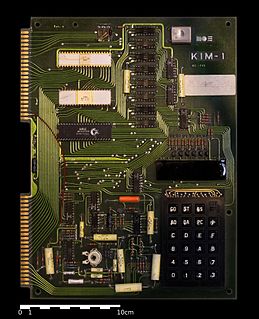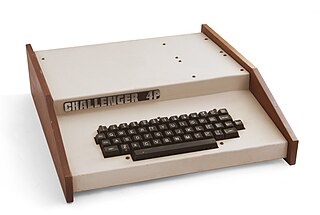
The Atari 2600, branded as the Atari Video Computer System until November 1982, is a home video game console developed and produced by Atari, Inc. Released in September 1977, it popularized the use of microprocessor-based hardware and of games stored on swappable ROM cartridges, a format first used with the Fairchild Channel F in 1976. The VCS was bundled with two joystick controllers, a conjoined pair of paddle controllers, and a game cartridge—initially Combat and later Pac-Man.

The MOS Technology 6502 is an 8-bit microprocessor that was designed by a small team led by Chuck Peddle for MOS Technology. The design team had formerly worked at Motorola on the Motorola 6800 project; the 6502 is essentially a simplified, less expensive and faster version of that design.

The 6800 is an 8-bit microprocessor designed and first manufactured by Motorola in 1974. The MC6800 microprocessor was part of the M6800 Microcomputer System that also included serial and parallel interface ICs, RAM, ROM and other support chips. A significant design feature was that the M6800 family of ICs required only a single five-volt power supply at a time when most other microprocessors required three voltages. The M6800 Microcomputer System was announced in March 1974 and was in full production by the end of that year.

MOS Technology, Inc., later known as CSG , was a semiconductor design and fabrication company based in Norristown, Pennsylvania, in the United States. It is most famous for its 6502 microprocessor and various designs for Commodore International's range of home computers.

Jay Glenn Miner was an American integrated circuit designer, known primarily for developing multimedia chips for the Atari 2600 and Atari 8-bit family and as the "father of the Amiga".
Acorn Computers Ltd. was a British computer company established in Cambridge, England, in 1978. The company produced a number of computers which were especially popular in the UK, including the Acorn Electron and the Acorn Archimedes. Acorn's BBC Micro computer dominated the UK educational computer market during the 1980s.

The KIM-1, short for Keyboard Input Monitor, is a small 6502-based single-board computer developed and produced by MOS Technology, Inc. and launched in 1976. It was very successful in that period, due to its low price and easy-access expandability.
Microsoft BASIC is the foundation software product of the Microsoft company and evolved into a line of BASIC interpreters adapted for many different microcomputers. It first appeared in 1975 as Altair BASIC, which was the first version of BASIC published by Microsoft as well as the first high-level programming language available for the Altair 8800 microcomputer.

The IMSAI 8080 was an early microcomputer released in late 1975, based on the Intel 8080 and later 8085 and S-100 bus. It was a clone of its main competitor, the earlier MITS Altair 8800. The IMSAI is largely regarded as the first "clone" microcomputer. The IMSAI machine ran a highly modified version of the CP/M operating system called IMDOS. It was developed, manufactured and sold by IMS Associates, Inc.. In total, between 17,000 and 20,000 units were produced from 1975 to 1978.

The Acorn Eurocard systems were a series of modular microcomputer systems based on rack-mounted Eurocards developed by Acorn Computers from 1979 to 1982, aimed primarily at industrial and laboratory use, but also home enthusiasts.

Ohio Scientific Inc. was an Ohio-based computer company that built and marketed microcomputers from 1975 to 1981. Their best-known products were the Challenger series of microcomputers and Superboard single-board computer kits.
Pravetz (Правец) were Bulgarian computers produced from 1979 until the early 1990s. They were manufactured in the town of Pravetz, with some components and software being produced in Stara Zagora, Plovdiv, and other Bulgarian cities.

Synertek, Inc. was an American semiconductor manufacturer founded in 1973. The initial staff consisted of Bob Schreiner, Dan Floyd, Jack Balletto, and Gunnar Wetlesen and Zvi Grinfas.
Raymond M. Holt is a computer designer and businessman in Silicon Valley.

The SYM-1 was a single board "trainer" computer produced by Synertek Systems Corp in 1975. It was designed by Ray Holt. Originally called the VIM-1, that name was later changed to SYM-1.

A microprocessor development board is a printed circuit board containing a microprocessor and the minimal support logic needed for an electronic engineer or any person that wants to become acquainted with the microprocessor on the board and to learn to program it. It also served users of the microprocessor as a method to prototype applications in products.

The history of the personal computer as a mass-market consumer electronic device began with the microcomputer revolution of the 1970s. A personal computer is one intended for interactive individual use, as opposed to a mainframe computer where the end user's requests are filtered through operating staff, or a time-sharing system in which one large processor is shared by many individuals. After the development of the microprocessor, individual personal computers were low enough in cost that they eventually became affordable consumer goods. Early personal computers – generally called microcomputers – were sold often in electronic kit form and in limited numbers, and were of interest mostly to hobbyists and technicians.

The British Broadcasting Corporation Microcomputer System, or BBC Micro, is a series of microcomputers and associated peripherals designed and built by Acorn Computers in the 1980s for the BBC Computer Literacy Project. Designed with an emphasis on education, it was notable for its ruggedness, expandability, and the quality of its operating system. An accompanying 1982 television series, The Computer Programme, featuring Chris Serle learning to use the machine, was broadcast on BBC2.












